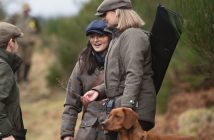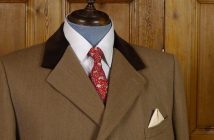While Nutter’s of the 1960s had been a vibrant playground for the young and hip, the 1980s saw some of contemporary fashion’s biggest names passing through the doors and it was during this period that Tim learnt the many facets of his craft. “John Galliano was on placement from Saint Martin’s and I was hanging out with that lot. From a design point of view I could draw but I hadn’t gone to design college. I understood how they started to put collections together. John was very good at display and I used to do some of that, so I had a really weird upbringing in tailoring. My background was shop floor but because I was a nosy bugger, when Tommy was doing collections I’d sketch something and put it on the table and he’d say, “That’s not bad, give us another few of those”, so I ended up going from downstairs on the tailoring side, to sales, to being him towards the end.”
After five years under the masterful hand of Tommy Nutter, Tim decided that it was time to move on and branch out. “I left because I got a bit disillusioned with Savile Row. I didn’t think it was very healthy and I didn’t like the fact that people didn’t appreciate what Tommy had done. Everyone moaned about how great the Italians were rather than saying how great we were. And I was more fascinated by what was going on with the designer brands; Hugo Boss had just started and Armani had opened a shop with Mrs Burstein. Now we go around and all these brands on the High Street are quite normal, but none of that existed at the time. So I went to work for a chap called Malcolm Levene in Chiltern Street and we had a very similar clientele to Paul Smith. I started buying for him and helped to re-establish his business. We would go through all the collections and buy what we thought our customers would like. So we kind of bespoked within the collection, and it used to drive the designers mad because some seasons we’d just buy shirts or we’d buy socks, and form our own collection.”
After Chiltern Street, Tim ventured into the world of styling and it was during this period that his Eureka moment came about. “I worked as a freelance stylist on a lot of films and with the growth of MTV in the later 1980s, styling all sorts of people like George Michael and the other contemporary bands. I was running around doing all these things and I had an idea that nobody was really looking at tailoring in a new way, and I wondered if it could be communicated to a designer-led audience.”
With ambitions to create his own brand, Tim focussed his efforts on finding a base for himself away from the traditional frontage of Savile Row. “I wanted to get a tailoring house and I tried to get a space on Golden Square which fell though. My mate then saw this derelict house in Waltham Park and I knew this area very well from my days of partying here in the 1980s, but I’d never been here by day, only in the early hours of the morning. I saw these Georgian houses and I was intoxicated. The floor was falling in so we took it out and created the illusion of a working house and that’s how I started Timothy Everest the brand; a little ready to wear, a little bespoke. I wasn’t sure that people would really get bespoke but very quickly that’s all people wanted from us.”
The New Bespoke Movement was coined by PR guru Alison Hargreaves after Tim showed her around the new atelier. Ozwald Boateng and Richard James had also broken away from the Savile Row mould and together they launched the movement to a wider audience, receiving great press and public interest. “She rightly said that we have to get this idea across that it’s a new movement, it’s not Savile Row, it’s this young guy in the East End doing bespoke tailoring, so she put us together and offered it up as a story to get some kind of traction. It reached its crescendo with the three of us in Vanity Fair.”
Tim’s business was booming and he eventually moved around the corner to his current premises on Elder Street, as further opportunities to expand the business arose. “We set up here in the early 1990s and by 2000 we had started working with M&S with some license agreements in the Far East. We were then head-hunted by Daks to become a consultant, and the Japanese wanted me on the board and were grooming me to be CEO. So I went from a derelict house to this, to running a 600 million pound business. We did that for three years and took it from a loss to a profit.”
Tim’s success in turning around the Daks brand was quite remarkable, especially for someone without a formal business background, and his achievements with the M&S collaboration have also proven that if you do something right and with attention to detail, a brand like Timothy Everest can straddle both high-end bespoke and the high street retail market without detriment to the image or the brand perception.
“I was trying to build a British institution. I didn’t want to set out to be trendy. Like in music terms, I’d rather be in the top ten for a long time than a fleeting number one hit. With M&S it was a British institution that needed a bit of help, Daks was an institution that needed modernising, and maybe I’m drawn to those kinds of things. We didn’t put our name on the product until Stuart (Rose) was there, because I was confident he was doing something good and it felt like it was the right thing to do. If you look at J. Crew collaborating with Belstaff for example, it doesn’t really matter so long as it’s done properly. I really believed that you could offer tailoring to real people and you don’t have to be elitist. The question was could we hit the right price point and the right margins to bring a better garment to the high street? And generally with our suits there you will pay four or five times greater for a designer brand with no difference in the quality, and I can say that because I know what goes into it.”




